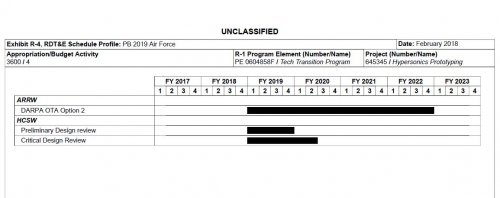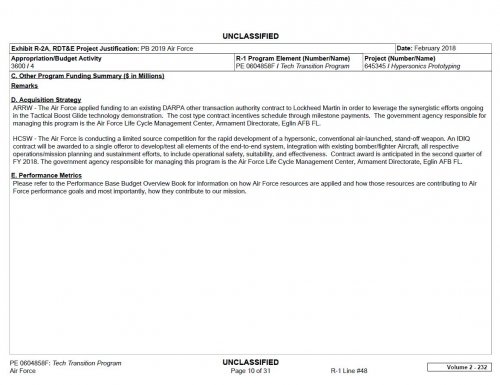The Air Force has established a nearly $1 billion program to prototype a long-range, air-launched, hypersonic strike weapon and Lockheed Martin has elbowed away two other competitors to win the project, the service has revealed.
Lockheed, which beat a Raytheon-Boeing team and another competitor for the Hypersonic Conventional Strike Weapon prototyping effort, now assumes a dominant role in leading two parallel Air Force projects that aim to develop a long-range, conventional prompt strike capability.
Spokesman for two other contractors the Air Force invited to compete in the HCSW program -- Northrop Grumman and Orbital ATK -- both declined to confirm whether their companies had submitted a bid or comment in any way on the contract award. Northrop is slated to acquire Orbital ATK this year. Debroah VanNierop, a Boeing spokeswoman, confirmed to Inside Defense the company was a subcontractor on a proposal led by Raytheon.
On April 18, the Air Force announced Huntsville, AL-based Lockheed Martin Space to be the “successful offeror” of a contract potentially worth $928 million to design, develop, and perform engineering, systems integration, test, logistics, planning and aircraft integration support of all elements of a hypersonic, conventional, air-launched, stand-off weapon.
The objective of the HCSW program, informally called “Hacksaw,” is to develop long-range hypersonic missile prototypes that can be integrated on the service's current bomber and fighter aircraft fleets and be supported in all operations, mission-planning and sustainment efforts, according to the Air Force.
“This effort is one of two hypersonic weapon prototyping efforts being pursued by the Air Force to accelerate hypersonics research and development,” said Ann Stefanek, an Air Force spokeswoman. “The Air Force is using prototyping to explore the art-of-the-possible and to advance these technologies to a capability as quickly as possible.”
The second Air Force prototyping project is the Air-Launched Rapid Response Weapon (ARRW), with support from the Defense Advanced Research Projects Agency, to also develop a long-range, prompt strike capability.
Stefanek declined to offer further detail about the programs, specifically whether the core technology of the projects was based around an air-breathing, hypersonic system or a hypersonic boost-glide system.
The full scope of the Hacksaw program -- which is slated to potentially fund work through engineering and manufacturing development -- was not previously known. The project was hatched in FY-18 as part of a “Lifecycle Prototyping” effort that sought $153 million to fund numerous technologies; it is not clear how much of that is allocated to Hacksaw. The Air Force's FY-19 budget request establishes a dedicated Hacksaw budget line, seeking $89.3 million. Future funding for the hypersonic conventional strike program was not previously disclosed.
By comparison, the ARRW -- which also was broken out from the Lifecycle Prototyping project for the first time in the FY-19 budget -- is seeking $169 million, a potentially bigger program.
The Air Force, according to the FY-19 budget request, plans to "leverage the synergistic efforts" of DARPA's existing contract with Lockheed Martin for a Tactical Boost Glide demonstration to further the ARRW program. It appears the Air Force's new ARRW project will overlap with the TBG program -- a joint DARPA-Air Force initiative to develop and demonstrate technologies to enable future air-launched, tactical-range hypersonic boost glide systems.
The scale of the Hacksaw project is comparable to the Pentagon's marquee effort over the last decade to develop technologies for a long-range hypersonic strike weapon as part of the Conventional Prompt Strike program, run by the Office of the Secretary of Defense. The Defense Department has spent $1.2 billion over the last 10 years to develop a boost-glide weapon and earlier this year disclosed plans to put the Navy in charge of the project beginning in FY-20, with the goal of outfitting submarines with a hypersonic strike weapon.
Last summer, the Air Force Life Cycle Management Center -- after asking industry to register interest in supporting Hacksaw requirements -- determined five companies were able to meet the service's needs: Boeing, Lockheed Martin, Northrop Grumman, Orbital ATK and Raytheon.
In the end, the Air Force received a total of three offers from industry, according to the announcement.
The Hacksaw program is being financed with funds from its advanced component development and prototyping accounts and is part of a larger Technology Transition Program to “demonstrate, prototype, and experiment with technologies and concepts to enable or accelerate their transition to acquisition programs and/or operational use,” according to the Air Force budget.
“The Technology Transition Program addresses the gap between initial technology or concept development and demonstration, and successful acquisition and operational capability implementation,” according to the Air Force's FY-19 budget request.
The Hypersonic Conventional Strike Weapon project integrates Air Force-enabled “system technologies into a prototype that will demonstrate the viability of this concept to be fielded as a long-range prompt strike capability,” according to the service's FY-19 budget request. “HCSW will design, develop, manufacture, and test, a number of prototype vehicles to inform decisions concerning HCSW acquisition and production,” the budget states.






